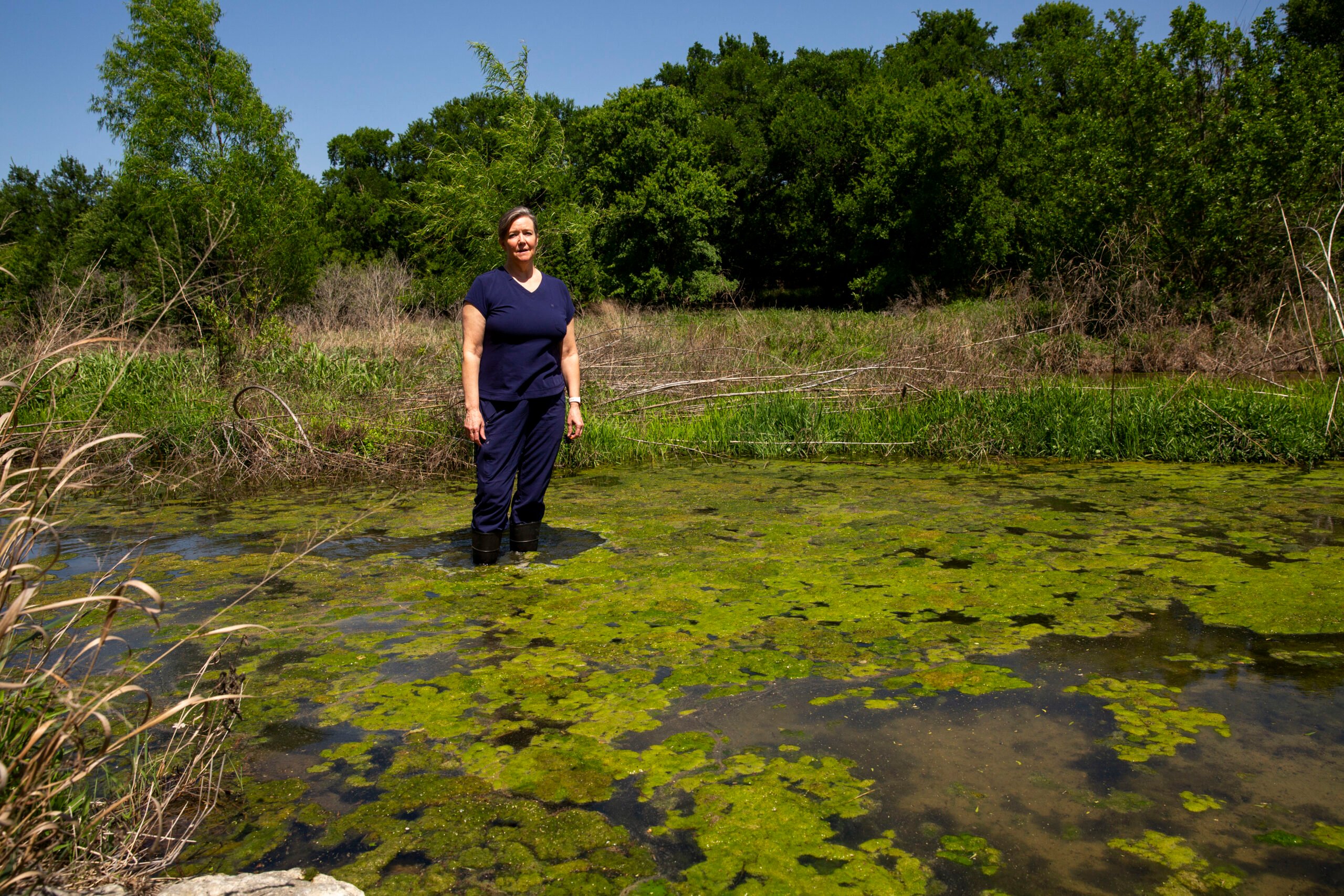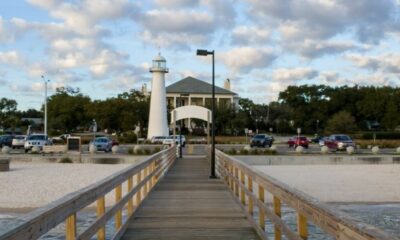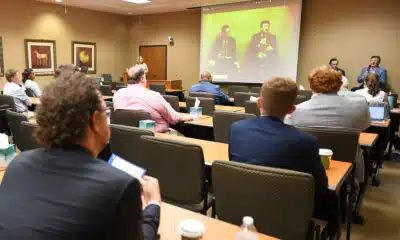News from the South - Texas News Feed
In Booming Central Texas, Wastewater Is Polluting Rivers and Streams
Editor’s Note: This article originally appeared at Inside Climate News, a nonprofit, independent news organization that covers climate, energy, and the environment. It is republished with permission. Sign up for their newsletter here.
Margo Denke set out to rally the town when she learned that a Christian youth camp planned to build a wastewater treatment plant and discharge its effluent into the pristine Hill Country creek that ran through her small ranch.
Denke, a 1981 graduate of Harvard Medical School who moved to the Hill Country in 2013, printed fliers, put them in Ziploc bags and tied them to her neighbors’ cattle gates in the tiny community of Tarpley, population 38. A coalition of families pooled resources, hired a lawyer and dug in for a yearslong battle.
Theirs was one of many similar struggles that have unfolded in recent years across Central Texas, where protection of creeks and rivers from treated wastewater discharge often falls to shoestring community groups as an onslaught of population growth and development pushes ever deeper into the countryside.
“All this would have been destroyed,” Denke said in April as she surveyed a spring-fed stretch of Commissioners Creek. “Raising the money to fight this is not easy. But you have to, you can’t let this just slide by.”
Eventually, the camp owner, who did not respond to a request for comment from Inside Climate News, agreed in settlement negotiations not to discharge into the creek. Instead, they would spray their treated effluent over their own property—an increasingly popular means of wastewater disposal. In exchange, the neighbors would drop their opposition to the two-story dam the camp erected for a private lake and waterpark on little Commissioners Creek.
“I’m trying to stay positive about it,” Denke said. “It was a huge win.”
But the battle never ends amid the rapid pace of development in Texas. Several miles downstream, another subdivision developer wants to treat wastewater and discharge it into Hondo Creek. And in a neighboring watershed, another community group recently stopped another Christian youth camp from discharging into the Sabinal River.
Similar stories repeat throughout Central Texas, where two decades of booming population growth have come with a massive increase in domestic wastewater—mostly human sewage. The effluent from wastewater treatment plants appears clean and clear, but it contains high levels of organic nutrients that can cause algae blooms and devastate native aquatic ecosystems when dumped into streams and rivers.

“Unfortunately, society at large has no idea,” said Jeff Back, a staff scientist at Baylor University who has studied nutrient pollution in Texas waterways for 20 years. “Developers want to continue to do their business, but they need to be responsible.”
Now, as the state Legislature meets for its biennial session, advocates for water protection are supporting a bill that would prohibit most new discharges of treated wastewater into the state’s last 21 stretches of pristine rivers and streams, as defined by measured nutrient levels. Filed by state Sen. Sarah Eckhardt, a Democrat from Austin, it’s the latest iteration of a bill that groups have tried repeatedly without success to pass in Texas.
It wouldn’t ban development along pristine streams. It would just require other outlets for treated wastewater beside the natural waterways. Plenty of solutions are available on the market, from systems for onsite re-use to treatment methods that remove the nutrients from wastewater.
“People have to understand that it’s not going to be free,” Back said. “People want to do everything as cheaply as possible.”
The luxury of doing things cheaply might not last forever. As Texas cities begin to outgrow their water supplies and state leaders increasingly recognize shortages looming on the horizon, there may come an end to the days of showering lawns with drinking water while dumping treated effluent into rivers for disposal.
“This effluent should be considered a resource, not a nuisance to get rid of,” said David Venhuizen, a civil engineer in Austin who sells hardware for on-site water reuse.
It could be used to irrigate and fertilize the turf grass of parks, sportsfields, golf courses and private lawns, which make up the bulk of municipal summertime water use in Texas. In existing cities, such reuse has proven prohibitively expensive because plumbing from wastewater treatment plants is expensive to run out to individual customers.
New development, however, could be built to incorporate on-site wastewater reuse, said Venhuizen. His system, buried underground like a septic system, can treat a household’s wastewater, then drip it beneath the lawn. It could also be adapted at neighborhood scale for subdivisions to create a decentralized network of wastewater treatment and local redistribution.
But the breathless pace of suburban sprawl in Texas leaves no time to pause and make systemic changes. Instead, Texas cities run pipelines to distant aquifers to meet the ever-growing needs of new neighborhoods that will use most of their drinking water on lawns while piping away their effluent for treatment and discharge into a creek.
“We’re going to continue to rely on extraction instead of any regenerative kind of water systems,” said Venhuizen, 78, on a rocking chair in his backyard fitted with rainwater collection tanks and covered in native plants. “The madness has to stop.”
Stephanie Morris bought a house on the South Fork San Gabriel River, 27 miles north of Austin, in 2013. She wouldn’t have done it if she knew what the beautiful river would become.
When she and her family moved in, Morris said, the neighbors were already exhausted by a long-running battle with the neighboring city of Liberty Hill over its discharge of treated wastewater into the river about a quarter mile upstream.
Back then, Liberty Hill had about 1,000 residents, and its discharge created relatively minor algae problems in the river. Then its population exploded, like many other small cities of Central Texas. Now almost 15,000 people live in Liberty Hill, most of them relying on the South Fork San Gabriel for their wastewater disposal needs.
“There’s a hell of a lot more people pissing in the pond,” said Morris, a high-risk labor and delivery nurse, as she trudged through the green, mucky river in high rubber boots. “Every year things would get worse as their volume increased.”
All those nutrients, primarily from human waste, have caused the riverbed to choke up entirely with algae at times, extending three to five miles downstream and burying native ecosystems. When the algae dies, it sinks and rots in heaps of black, stinking muck.
Year by year, Morris became increasingly involved, until she spent all of her free time trekking the riverbed and taking photos of the destruction to show to her elected representatives, commissioners of the TCEQ and judges at the administrative law courts in Austin.
As a result, the TCEQ has twice reduced the concentrations of phosphorus that the Liberty Hill plant is permitted to discharge, although its overall volume continues to increase. The river looks better today than it did several years ago, Morris said. But the fight has nearly exhausted her.
“This has cost so much time and money, it’s not even funny,” she said. “Private citizens should not have to be enforcing the environmental standards of the state.”
The story of the South Fork San Gabriel, and the pictures that circulated online, jolted other communities to fight against proposed discharges in their areas, said Annalisa Peace, executive director of the Greater Edwards Aquifer Alliance, a group that helps its member organizations challenge the proposed discharge permits in the 21 counties that overlie the Edwards and Trinity aquifers.
“It’s incumbent upon the citizens and GEAA to raise the money for the legal fees to do all this,” Peace said. “It seems to be that the burden is placed on the average citizen.”
Most new wastewater sources come from new housing subdivisions and the municipal utility districts that are established to serve them, she said. Others are commercial projects, from summer camps to music venues, that plan to treat their own wastewater. Much of the new construction, especially near pristine streams, takes place outside of any city’s jurisdiction so it faces little regulation or oversight.
Previous attempts to pass statewide regulations of discharges into waterways have repeatedly failed, said Peace, who has worked with GEAA for 20 years. Much of the resistance comes from lobbying by major homebuilding companies that are making big money off explosive population growth in Texas.
“It’s the big nationals that we’re really seeing the most intransigence and the most organized opposition from,” she said. “They don’t like regulation.”
The Texas Association of Builders declined to comment on this report.
Peace wishes for a law increasing treatment standards for wastewater discharge into all Texas waterways. But she’ll settle for the current bill, which protects just the remaining pristine segments, and provides exemptions for cities and river authorities.
Outside the Texas Legislature, groups have had more success challenging individual permits. Such was the case on the Upper Sabinal River, where another Christian youth camp, operated by the national nonprofit Young Life, proposed in 2019 to build a wastewater treatment plant that would discharge into the river. Local landowners rallied. They gathered 25,000 signatures on a petition and hired a lawyer to challenge the discharge permits.
Faced with an extensive delay in state administrative courts, Young Life opted to settle instead. Young Life did not respond to a request for comment.
“Once this became a high-profile issue, they were willing to look at alternatives,” said Jeff Braun, a landowner on the upper Sabinal River and a spokesperson for the Bandera Canyonlands Alliance, which fought the permit. “I think it hit a chord with a lot of people that are native Texans because they all love these iconic streams.”
In an announcement of the settlement agreement in August 2021, Young Life said it would reuse most of its wastewater on-site for irrigation rather than discharging into the river. Regulators call this practice “land application,” and it’s growing in popularity.
By banning discharges into pristine streams, the bill in the Legislature would effectively force developers in those areas to use land application for wastewater disposal. Although the practice is less impactful to waterways than direct discharge, it can still do damage.
Mike Clifford, technical director at the Greater Edwards Aquifer Alliance, said that opposition from community groups has already pushed many developers to seek land application permits.
“The problem now is we just have too many of these,” he said. “They’re popping up everywhere.”
The TCEQ has issued 413 active permits for land application of treated wastewater, according to online records, and 2,374 active permits for discharge.
For example, community groups are currently fighting a planned 10,000-seat amphitheater, luxury hotel and condominium complex on 84 acres nestled next to the Barton Creek Habitat Preserve on Barton Creek, a pristine stream, in Austin. The complex would treat its own wastewater with land application permits to spray up to 120,000 gallons per day of treated effluent onto its property.
Over time, Clifford said, the nutrient pollutants would accumulate until a big rainstorm washes them into Barton Creek. About five miles upstream, on Fitzhugh Road, another proposed 5,000-person music venue wants to treat its own wastewater and discharge it into ponds near Barton Creek.
One solution, Clifford said, would be for Texas to require developers to add nutrient removal to their treatment process.
“It’s just about money,” he said. Nutrient removal “can double the cost of a wastewater treatment plant.”
With adequate investment, plenty of solutions exist. Some could even be configured to make money that covers part of their costs. For example, some treatment systems that remove nitrogen and phosphorus from water do it by growing algae, which could be harvested and sold as fertilizer. To avoid the buildup of nutrients where effluent is sprayed onto land, grasses can be harvested and sold as hay. Irrigation of hay for livestock is the largest water demand driving shortages in parts of Texas and the West.
Eventually, water scarcity will compel urban planners to make use of wastewater rather than dumping into rivers, said Brian Zabcik, advocacy director for the Save Barton Creek Association, which has pushed for discharge protections on Texas pristine streams through several successive legislative sessions.
“It’s crazy that we’re using our highest-quality drinking water to water our lawns and flush our toilets,” he said. “It makes a lot more sense to use recycled wastewater for those purposes.”
Texas might soon have to consider systemic changes as its population continues to boom, temperatures continue to rise, a multi-year drought persists and water shortages approach. Already, changes are beginning in small pockets.
Zabcik pointed to West Texas cities of Big Spring and El Paso, national pioneers in the reuse of treated effluent for drinking water. In Austin, a new city government building features on-site wastewater treatment and recycling for non-potable uses. Consumer products exist to do the same at any home, building or neighborhood.
These aren’t radical practices, said Zabcik, who lives on his grandparents’ ranch in Bell County. Conserving water was part of life for previous generations in Texas. For example, Zabcik said, his grandparents grew a garden, but not with their drinking water; they ran in a pipe from their stock tank. The water from their washing machine drained onto the lawn.
Passing protections on pristine streams won’t ban development along those stretches, Zabcik said. It will just require new approaches to wastewater use. Although they remain costly for now, prices may come down as necessity boosts demand for new affordable products.
The timeline will depend on whether Texas finds the political will to implement new wastewater systems in advance, or if it waits for scarcity conditions to force its hand.
“We’ve got to reuse every drop,” Zabcik said. “It’s really stupid to be wasting wastewater.”
The post In Booming Central Texas, Wastewater Is Polluting Rivers and Streams appeared first on www.texasobserver.org
Note: The following A.I. based commentary is not part of the original article, reproduced above, but is offered in the hopes that it will promote greater media literacy and critical thinking, by making any potential bias more visible to the reader –Staff Editor.
Political Bias Rating: Center-Left
The content reflects a strong focus on environmental conservation, community activism, and the impact of development on natural resources. It presents the struggles of local communities in Central Texas against wastewater discharge into pristine rivers, framing these efforts as necessary for protecting the environment. The mention of political figures such as Democrat Sarah Eckhardt and advocacy for regulatory changes indicates a tendency toward policies aimed at environmental protection, often associated with more progressive or center-left positions. The article also critiques the role of developers and industry in resisting regulation, which aligns with a broader environmentalist agenda.
News from the South - Texas News Feed
The History of Eugenics in Texas Isn’t What You Think
I’ll admit: Having grown addicted to the treats of literary nonfiction, I don’t make it through too many academic histories these days. If I’m going to, there’d better at least be a decent lede—and the Marxian opening to a new history of the eugenics movement in Texas fits the bill.
“Monsters haunted the imaginations of some of the most educated white Texans from the 1850s to the dawn of World War II,” tees off The Purifying Knife: The Troubling History of Eugenics in Texas, a 300-page (endnotes included) work by husband-wife historians Michael Phillips and Betsy Friauf.
Philips, who recently retired from a teaching position at the University of North Texas in Denton, previously authored White Metropolis, a well-regarded history of race in Dallas.
The new book, out June 3 from University of Oklahoma Press, unearths a cast of unsavory Texas characters who pushed eugenics—the discredited pseudoscientific belief that the human species should be improved through practices such as forced sterilization—from the mid-19th century through the 1930s. In the latter decades of that period, the majority of U.S. states enacted forced-sterilization laws that targeted the non-white and the disabled, leading to more than 60,000 coerced operations. But Texas, perhaps surprisingly, never passed such a law.
“Although a violent and white supremacist place, Texas remained on the sideline during this particular American carnage,” the authors write. The reasons why are the book’s most interesting subject.
Though the Lone Star State ultimately resisted eugenics, it was home to early pioneers. A Georgia-Texas transplant, Gideon Lincecum was a botanist and surgeon who “one day in the 1850s took it upon himself to castrate an alcohol-dependent patient in Texas, an assault he said cured his involuntary test subject’s addiction.” Lincecum did so before the term eugenics had even been coined, and he became one of the earliest advocates of treating humans more like a breeder treats horses or dogs. Lincecum managed to get the nation’s first forced-sterilization bill put before the Texas Legislature in 1853. But Lincecum, much too far ahead of his time, saw the bill fizzle amid “copious mockery.”
F.E. Daniel, another physician and editor of the Texas Medical Journal from the 1880s until the 1910s, pushed for forced vasectomy and hysterectomy to assure Anglo-Saxon dominance, the book’s authors report. Daniel “embodied the values of the southern Progressive movement,” a particular turn-of-the-century brew that mixed scientific rationalism with rank racism. Eugenicists also made inroads at Texas universities, particularly UT-Austin and Rice.
But Progressives and egghead professors were poor messengers in a state where politicians like “Pa” and “Ma” Ferguson stoked right-wing populist prejudice against government and academic elites—and where religious fundamentalism was a rising political power. Eugenicist proposals, whether focused on sterilization or restricting who could marry, continued to fail.
“Attacks on colleges and universities, therefore, provided the unintentional benefit of shielding the poor and politically powerless in Texas from a horrifying, widely shared elite agenda that prevailed elsewhere,” the authors write. In fact, liberal California was the nation’s eugenic epicenter, where deference to academic expertise helped fuel the largest number of forced sterilizations among states—a practice continued through 1980.
Further frustrating the Texas eugenicists, a large portion of the state’s capitalists depended on cheap Mexican labor and weren’t going to forsake their bottom lines over abstract concerns about race-mixing. John Box, an East Texas Congressman, attempted to overcome these employers when federal lawmakers passed the deeply racist Immigration Act of 1924, which sought to halt immigration from Asia and Eastern and Southern Europe. Box pushed for a cap on Mexican immigration, too, but the Western Hemisphere was ultimately exempted.
“To the wealthy landowners exploiting migrant labor, the threat of paying higher wages proved far more frightening than any dysgenic nightmare that Box and his allies could conjure,” the authors write.
Ultimately, the combination of greedy capitalists, right-wing anti-intellectualism, and solidifying religious opposition (Catholics grew rapidly in Texas during these decades, and the Vatican explicitly opposed forced sterilization in 1930) doomed eugenicist legislation that was considered in Austin between the 1850s and the 1930s. In an email to the Observer, Philips called this “a unique alignment that led one set of bad ideas … to defeat another malign worldview.” Soon, the eugenics movement began its fall from grace nationwide as the discovery of Hitler’s concentration camps generally tarnished proposals for racial engineering.
The history laid out in this book could tempt one to reassess today’s right-wing populist attacks on academia. Perhaps these, too, could end up being right for the wrong reasons. But Philips doesn’t think so.
He attributes universities’ erstwhile embrace of eugenics to higher education’s status as “almost universally white, straight, American-born, male, and wealthy.” More diverse scholarly bodies would have likely eschewed such ideas; a Jewish anthropologist, Franz Boas, eventually did help puncture the movement’s pseudoscience, for example. “That’s why the attacks [today] on diversity, equity, and inclusion today are so dangerous,” Philips wrote the Observer. “It threatens to make universities more like they were at the time eugenics became widely accepted wisdom.”
The book takes a pass through more recent figures trying to revive race science in America, like Charles Murray and Richard Spencer, and the authors also highlight the eugenics-adjacent rhetoric of today’s rabidly xenophobic politicians—namely the U.S. president and the governor of Texas. A bit more provocatively, they tie threads between eugenics and the current fight over abortion. While some on the right make hay of the historic ties between eugenics and early advocates for reproductive rights, the authors take another tack by focusing on the power allowed or disallowed to the state.
“The battle over the right of the state to control reproduction once centered on preventing children labeled as dysgenic from being born. By 2023, the state decided it could force women to give birth even when the child had no chance of survival,” they write. “The two great battles in Texas over government power and bodily integrity since the 1850s, eugenics and abortion, had very different outcomes.”
The post The History of Eugenics in Texas Isn’t What You Think appeared first on www.texasobserver.org
Note: The following A.I. based commentary is not part of the original article, reproduced above, but is offered in the hopes that it will promote greater media literacy and critical thinking, by making any potential bias more visible to the reader –Staff Editor.
Political Bias Rating: Center-Left
The content critically examines historical and contemporary issues linked to eugenics, racial discrimination, and right-wing populism, emphasizing the negative impact of these ideologies and highlighting progressive critiques such as the dangers of attacks on diversity and inclusion. While it acknowledges complexities within politics and history, the article leans toward a center-left perspective by focusing on social justice, systemic racism, and the defense of academic and reproductive freedoms.
News from the South - Texas News Feed
LIST: Top priority cold homicide cases Texas Rangers are still trying to solve
SUMMARY: The Texas Department of Public Safety (DPS) is investigating over 145 unsolved homicides, with 13 prioritized cases involving victims from children to adults. These cold cases span decades and regions in Texas, including Dallas, Houston, Universal City, Lubbock, and more. Notable cases include 7-year-old Elizabeth Lynne Barclay, missing and murdered in 1979, and the 1980 Christmas Day murders of Estella and Andrew Salinas in Houston. Other cases involve victims like Yolanda Herrera (1981), Richard Garza (1984), and Marianne Wilkinson (2007), each with unresolved circumstances. Texans can submit tips to the Texas Rangers or Crime Stoppers for assistance in solving these cases.
The post LIST: Top priority cold homicide cases Texas Rangers are still trying to solve appeared first on www.kxan.com
News from the South - Texas News Feed
Responders from Mexico help with Texas flood response
SUMMARY: Responders from Mexico are assisting Texas in flood recovery along the Guadalupe River. A team of about 45 rescuers from Nuevo Leon, equipped with boats, ATVs, drones, and search dogs, volunteered to aid Kerr County after catastrophic floods. Eric Cavazos, director of Mexico’s Civil and Emergency Response Agency, emphasizes that their help is driven by humanity, not politics. The team’s search and rescue work has been vital, marking key locations and locating missing persons. Despite the emotional challenges, including finding personal items like a teddy bear, the Mexican responders are committed to continuing the mission until all those missing are found.
Dallas-Fort Worth news and weather from the FOX 4 weekend team.
Subscribe to FOX 4: https://www.youtube.com/fox4news?sub_confirmation=1
Dallas news, weather, sports and traffic from KDFW FOX 4, serving Dallas-Fort Worth, North Texas and the state of Texas.
Download the FOX LOCAL app: fox4news.com/foxlocal
Watch FOX 4 Live: https://www.fox4news.com/live
Download the FOX 4 News App: https://www.fox4news.com/apps
Download the FOX 4 WAPP: https://www.fox4news.com/apps
Follow FOX 4 on Facebook: https://www.facebook.com/Fox4DFW/
Follow FOX 4 on Twitter: https://twitter.com/FOX4
Follow FOX 4 on Instagram: https://www.instagram.com/fox4news/
Subscribe to the FOX 4 newsletter: https://www.fox4news.com/newsletters
-
News from the South - North Carolina News Feed6 days ago
Learning loss after Helene in Western NC school districts
-
News from the South - Missouri News Feed6 days ago
Turns out, Medicaid was for us
-
Local News7 days ago
“Gulfport Rising” vision introduced to Gulfport School District which includes plan for on-site Football Field!
-
News from the South - Florida News Feed6 days ago
The Bayeux Tapestry will be displayed in the UK for the first time in nearly 1,000 years
-
News from the South - Tennessee News Feed1 day ago
Bread sold at Walmart, Kroger stores in TN, KY recalled over undeclared tree nut
-
News from the South - Louisiana News Feed7 days ago
With brand new members, Louisiana board votes to oust local lead public defenders
-
Mississippi Today4 days ago
Hospitals see danger in Medicaid spending cuts
-
News from the South - Texas News Feed4 days ago
Why Kerr County balked on a new flood warning system















































